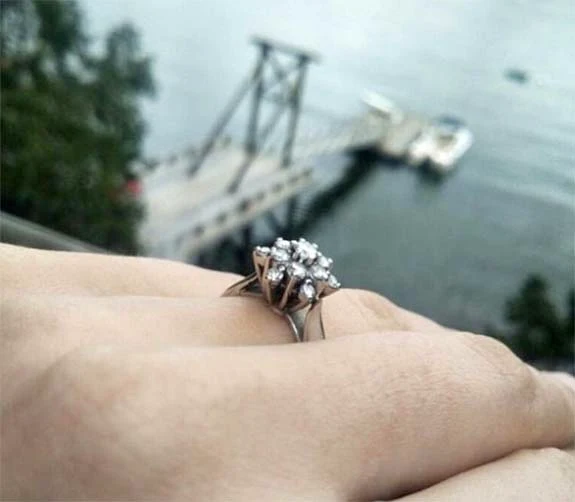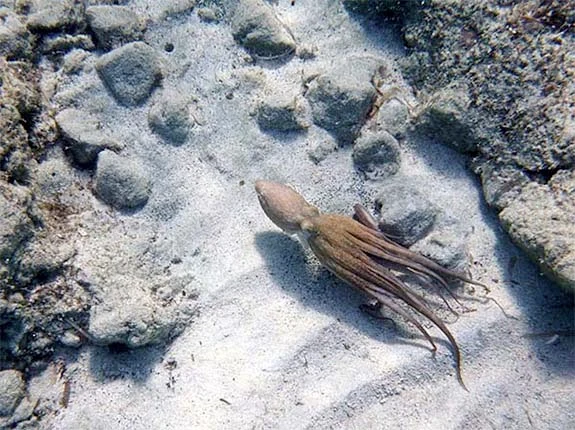
A Canadian woman who lost her engagement ring while swimming in Howe Sound off Bowyer Island, British Columbia, is thanking a baby octopus for leading divers to the irreplaceable heirloom that had been in her fiancé's family since the 1940s. As the world's smartest invertebrates, octopuses have great memories, can carry out complex tasks and — thankfully — have a penchant for shiny objects.
On Friday evening, 26-year-old Annika Parkinson-Dow was enjoying a swim off her neighbor's dock, where she marveled at the bioluminescence as she moved her hands back and forth across the surface of the dark water.
It wasn't until much later that Parkinson-Dow realized that her engagement ring was no longer on her finger. The diamond cluster ring, which was originally cherished by the grandmother of her fiancé Colby Crockett, had slid off in the cool water.
https://www.youtube.com/watch?v=ZJl65KUBxhE
The next morning, a heartbroken Parkinson-Dow sought professional help by contacting diving schools in the Vancouver area. Within an hour, a team of divers was ready to get to work.
"I was pretty sure that there was absolutely no chance [they'd find] it, a needle in the haystack," she told CBC.com. "I wasn't even sure of the exact spot that I lost it."

After an hour in the murky water near the dock, the divers were about to give up. But then they spotted a baby octopus and decided to follow it.
Octopuses are known to decorate their dens with shiny objects, including crustacean shells, sea glass and bottle caps. That pile of bling is often called an octopus's garden, a theme made famous in a song of the same name by Ringo Starr and the Beatles in 1969.
In 2007, a South Korean fisherman caught a tiny octopus that had been clinging with its tentacles to a porcelain plate dating back to the Goryeo Dynasty. Porcelain from that period is regarded as some of the finest ever made. When archaeologists searched the area, they discovered a 12th century shipwreck filled with priceless porcelain and other ancient artifacts.
Back at Bowyer Island, the baby octopus led the divers directly to the ring. The cluster of diamonds was glinting in the water.
Parkinson-Dow said, "My guess there is that if the octopus put it out in front of its little den. When it saw the divers, it probably thought, 'Well, I don't want anything to do with those divers, I'm going to hide,' and if the divers then followed it back to its home, that's where it might have left the ring."
With the diamond engagement ring now safely back on her finger, Parkinson-Dow promised never to swim with it again.
Credits: Ring and couple photo by Annika Parkinson-Dow. Octopus image by Ansgar Gruber / CC BY-SA.
Octopuses are known to decorate their dens with shiny objects, including crustacean shells, sea glass and bottle caps. That pile of bling is often called an octopus's garden, a theme made famous in a song of the same name by Ringo Starr and the Beatles in 1969. In 2007, a South Korean fisherman caught a tiny octopus that had been clinging with its tentacles to a porcelain plate dating back to the Goryeo Dynasty. Porcelain from that period is regarded as some of the finest ever made. When archaeologists searched the area, they discovered a 12th century shipwreck filled with priceless porcelain and other ancient artifacts. Back at Bowyer Island, the baby octopus led the divers directly to the ring. The cluster of diamonds was glinting in the water. Parkinson-Dow said, "My guess there is that if the octopus put it out in front of its little den. When it saw the divers, it probably thought, 'Well, I don't want anything to do with those divers, I'm going to hide,' and if the divers then followed it back to its home, that's where it might have left the ring." With the diamond engagement ring now safely back on her finger, Parkinson-Dow promised never to swim with it again. Credits: Ring and couple photo by Annika Parkinson-Dow. Octopus image by Ansgar Gruber / CC BY-SA. The Chalk Emerald’s impressive clarity, color, size and regal lineage rank it among the world’s finest examples of May’s official birthstone. Exhibiting the most highly prized velvety deep green color, the 37.82-carat Chalk Emerald is displayed near the Hope Diamond in the National Gem and Mineral Collection at the National Museum of Natural History in Washington, D.C. The gem was sourced in the famous emerald-mining area near Muzo, Colombia — a destination widely known as the world capital of emeralds. The Smithsonian reported that emeralds were cherished by the indigenous people of Colombia for at least 1,000 years before the arrival of Spanish conquistadors in the 1500s. The riches coming from the Colombia mines were of great interest to the Mughal rulers of India, who were captivated by the green gems. This demand sparked a robust gem trade linking the New World to the Middle East and India. Legend states that the Chalk Emerald was once the centerpiece of an emerald-and-diamond necklace belonging to a Maharani of the former state of Baroda, India. The Smithsonian noted that the faceted stone originally weighed 38.4 carats, but was later recut (losing more than 1/2 carat in weight) and set in a platinum and gold ring designed by Harry Winston. The ring features the square emerald-cut stone surrounded by 60 pear-shaped diamonds totaling 15 carats. The extraordinary ring was purchased by O. Roy Chalk, the New York-based real estate, transportation and media mogul, for his wife, Claire. The couple generously donated the Chalk Emerald to the Smithsonian in 1972, where it has been on exhibit ever since. Emerald is the most valuable variety of the beryl family and is known to display a wide variety of visible inclusions, which are referred to as “jardin” (French for “garden”). These imperfections do not detract from the stone’s beauty but, instead, give each stone a unique fingerprint and distinct character. The name “emerald” comes indirectly from the ancient Greek word for green gem, “smaragdos.” Besides being the birthstone for the month of May, it’s also the preferred gemstone to honor 20th and 35th wedding anniversaries. Credits: Images courtesy of Smithsonian/Chip Clark.